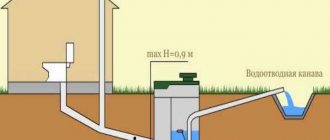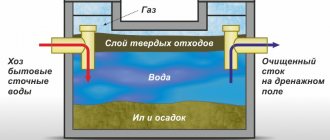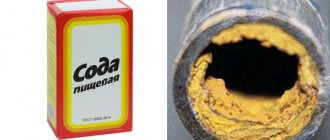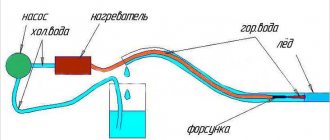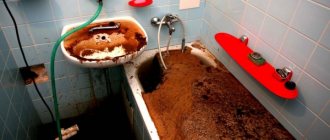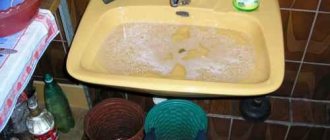Owners of private houses and country toilets with independent sewage systems have to decide on cleaning the cesspool. An overflowing waste storage facility is a source of environmental pollution, unpleasant odors and the spread of infections.
Previously, the problem of cleaning street toilets was solved only mechanically - with the help of a cesspool machine. Modern means, including biologically active preparations and chemistry for septic tanks, allow you to effectively and inexpensively dissolve and dispose of waste without the frequent use of machinery and equipment, thereby reducing the cost of cleaning cesspools.
TOP 7 bacteria for septic tanks
| Place | Name | Peculiarities |
| 1 | Thetford B-Fresh Green | Works at any temperature |
| 2 | Latrin (Latrin) | Environmental friendliness and safety. Does not harm plastic and rubber parts, does not corrode paint and varnish coatings |
| 3 | Doctor Robik 509 | Completely eliminates odors |
| 4 | Thetford Liquid Aqua Kem Green | High efficiency even when handling solid waste |
| 5 | BioBac | Contains anaerobic microorganisms and biologically active enzymes |
| 6 | Biola Sea Breeze | Completely safe for the environment |
| 7 | Himola Septic-10 | Neutralizes chemically active substances. |
Thetford Toilet liquid B-Fresh Green 2 l
Thetford B-Fresh Green (Netherlands) is intended for filling the bottom tank of a dry closet. Breaks down solid waste particles, neutralizes gas formation, and eliminates unpleasant odors.
It takes first place in the ranking due to the optimal price-quality ratio. The peculiarities of the product lie in the temperature regime of its use - from -20 0 C to +40 0 C.
Characteristics:
- Available in liquid form, ready for use. Does not require preliminary preparation.
- Validity period: 36 months.
- 75 ml of liquid cleans 10 liters of waste in a dry closet. It is recommended to use every three days.
- One canister is designed for 26-27 cleanings.
- Environmentally friendly composition without formaldehyde and other hazardous substances.
Pros:
- Low price.
- Convenient packaging (canister).
- Economical consumption.
Minuses:
- Moderate effectiveness.
- Reduces but does not eliminate odor completely.
Latrin (Latrin)
Latrin is designed for the disinfection of cesspools, dry closets, and septic tanks. The manufacturer of CleanBox promises the dissolution of fats and solid waste, an antiseptic effect, and the elimination of gases and odors.
The formula does not contain acids or alkalis, so the composition does not destroy plastic and rubber parts, does not dissolve varnish or paint. It is important to follow the dosage. When working with the product, you should use skin protection. You can find out more information on the website
Characteristics:
- Release form liquid.
- Validity period: 36 months.
- 25 ml of liquid is consumed for 10 liters of waste in a dry closet. The ratio changes for outdoor toilets and septic tanks.
- Sold in volumes of 1 l and 5 l. The consumption will be respectively: 40 and 200 cleanings of the dry closet.
The product in practice confirms its effectiveness for each point declared by the manufacturer.
Pros:
- Environmentally friendly.
- Does not destroy the body material.
- Used to disinfect any surfaces.
Minuses:
- Freezing.
- May irritate skin.
Doctor Robik 509 Care product for septic tank cesspools 0.798 l
Dr. Robik 509 effectively cleans waste in cesspools and other local systems. Used for recycling organic waste at home and on farms.
Before using this chemical for a septic tank, the manufacturer recommends cleaning an overflowing system. The product thins thick media, dissolves fossils, and cleans pores in the ground. Suitable for neglected sewer and drainage systems. Despite the power of exposure, it is safe for people, animals and flora.
Characteristics:
- Release form liquid.
- Validity period: 36 months.
- The canister is intended for one use per 3000 liters.
- Without special indications, repeat annually.
To get optimal results in clogged septic tanks, treatment is carried out several times in a row.
Pros:
- Safe for the environment.
- Use once a year.
- Removes odors.
Minuses:
- You need to pre-clean the pit using a vacuum cleaner.
Thetford Liquid Aqua Kem Green 1.5 l
Thetford Aqua Kem Green can be used every day to keep your dry closet clean. Has a biological, disinfectant, deodorizing effect.
With regular use, the duration of exposure increases to 4 days. May freeze at temperatures below -20 0 C. After defrosting, efficiency does not decrease.
Characteristics:
- Release form liquid.
- Validity period: 36 months.
- 75 ml of liquid is consumed per 10 liters of waste in a dry closet.
- One canister is designed for 20 cleanings.
The product thoroughly cleans and perfectly scents the toilet.
Pros:
- High efficiency.
- Nice smell.
Minuses:
- Not very economical consumption.
BioBac Biological agent for septic systems BBS 180 1 l
BioBac BB-S 180 is designed to eliminate odors, dissolve waste, detergents, soap, and dilute sediment in septic systems. Allows you to rarely perform sewage disposal.
Contains anaerobic microorganisms and biologically active enzymes, which create conditions for the full functioning of sewage treatment plants.
Characteristics:
- Release form liquid.
- Validity period: 24 months.
- Designed for 2 m3.
- The result lasts 180 days.
The bioactivator lives up to expectations, but the residue in an open bottle quickly loses its quality, so the next application may be less effective.
Pros:
- Safe composition.
- Wide spectrum of action.
- Accelerates biological processes.
Minuses:
- Efficiency decreases when an open bottle is stored for a long time.
Ecoservice Liquid for composting toilets Biola Sea Breeze 1 l
Biola septic tank product is poured into the lower tank in dry closets, outdoor toilets and cesspools. Neutralizes unpleasant odors, breaks down waste, stops gas formation and rotting.
It contains biodegradable components, so the product is absolutely safe. Can be composted. The concentrate is diluted in water according to the manufacturer's dosage table.
Characteristics:
- Release form liquid.
- Validity period: 36 months.
- 120 ml is poured into a 250 liter tank. See chart on bottle.
- Economical consumption.
Sea breeze has a pleasant aroma, low price and economical consumption.
Pros:
- High efficiency.
- Convenient use.
- Economical consumption.
Minuses:
- Must be diluted in water before use.
Himola Septic-10 concentrate 1 l
The list of top products is completed by Himola Septic-10 for cleaning septic systems. Breaks down organic and inorganic waste, eliminates unpleasant odors.
A bioactivator with an enzyme composition neutralizes chemically active substances that enter the sewer system with washing and cleaning powder. Regular use allows you to clean pipes from build-up and sediment.
Characteristics:
- Release form liquid.
- Validity period: 24 months.
- Pour 1-2 caps into the toilet.
- Use weekly.
Can be used both to remove clogged sewer systems and as a preventative measure to maintain cleanliness.
Pros:
- Easy to use.
- Safety.
- Economical consumption.
Minuses:
- Frequent use.
Causes and symptoms
Before figuring out how to clean a cesspool of sludge, you should understand why the pollution occurred and, of course, know how to recognize it.
Causes
The key reason that a cesspool or septic tank silts up is improper operation. As a result of the fact that the containers are not emptied on time, grease settles on the walls, which complicates the filtration process. This problem is especially noticeable in cesspools, since the walls of such a collector and the bottom filter the wastewater. If problems arise with this, the user has to clean the pit much more often.
Important! Another problem why a cesspool fills up quickly is the lack of bacteria that process sludge. If they are not brought into the cesspool at all, it will silt up very quickly.
Bacteria perform very important functions, including:
- Liquefaction of sludge, reducing its volume, helps prevent silting of the walls and bottom.
- Bacteria remove unpleasant odors.
- They clean the inside of the pipeline.
- The structure of the soil becomes porous, which facilitates the removal of liquid from the pit.
Important! Experienced people recommend not pumping out the cesspool until the last moment, since the more liquid there is, the greater the pressure on the walls and bottom, the more likely it is that water and sewage will seep into the soil. At the same time, after the first pumping, the remaining sludge dries on the walls and bottom of the pit and clogs the liquid seepage paths.
Remember! After the first pumping of the cesspool, its ability to filter and drain liquid will decrease sharply! You will have to increasingly call sewer trucks for pumping.
Signs
It is quite easy to understand that a drainage pit or septic tank has silted up; signs of this process:
- The useful volume has decreased.
- The pit is filling up much faster than before.
- You can notice fatty accumulations on the walls - this also reduces the volume, moreover, it prevents waste from passing through the walls.
- A sharp, unpleasant odor appears. Of course, the smell will be there in any case, but if it hurts your nose too much, you should figure out what the problem is.
- The layer of silt can be seen from the inspection hatch.
The designs of a cesspool and a septic tank are different, but the latter often suffers from siltation, in particular the wastewater settling chamber. The septic tank will quickly signal a problem if you regularly inspect the installation through the inspection well.
What are chemicals for cesspools and septic tanks?
Chemicals for a septic tank are special preparations, solutions that are added to an autonomous sewer system as reagents for disinfection and disinfestation of waste. As a result of the reaction that occurs, the components of the sewage either dissolve or turn into sparingly soluble and settle to the bottom.
Chemicals for septic tanks are divided into several main subgroups:
- Formaldehyde. These cleaners, made from formic acid, are the most affordable. They have powerful antiseptic properties and antibacterial effect. A few years ago, this cleaner was used everywhere, but recently scientists have proven the high toxicity and carcinogenicity of formaldehyde-based preparations, and now the products are practically not used.
- Bleach is just as toxic and dangerous to human health as the previous reagent, although with the danger of an epidemic, it is difficult to find the best means for destroying dangerous viruses and bacilli. Despite their high antibacterial and disinfectant effectiveness, chlorine compounds are not currently used as an antiseptic.
- Nitrate oxidizers. Nitrogen-based drugs have a different principle of action. They are environmentally friendly. The chemical components of the compounds react with sewage, dissolve it, separate it, turning it into a mass that is homogeneous in structure, which is easy to remove using a sewer truck. Such reagents contain surfactants that have a good dissolving and cleaning effect. Another important positive point in nitrate compounds is that they dissolve fats and do not form plaque on the walls of sewer pipes. The only drawback of nitrogen-based drugs is their high cost, which makes regular use of the products problematic.
- Preparations based on ammonium salts. These products quickly dissolve bacteria at the cellular level and effectively eliminate odors. Ammonium products have a significant disadvantage - they are sensitive to the effects of detergents, that is, if there is soap waste in the wastewater, the effect of the reagent for decontaminating fecal matter will decrease. Science has not yet sufficiently studied the issue of the impact of reagents on the environment, therefore it is not recommended to discharge purified water into open ground; it is better to remove it using sewer equipment.
Thus, the main chemistry for a septic tank, which is used to clean sewer structures, are products based on quaternary ammonium salts and nitrate oxidizers.
The effect of chemistry for cleaning a septic tank
What are the benefits of using chemical compounds as a cleaner for cesspools and autonomous sewers?
Once in the sewer, the septic tank chemicals react with organic and inorganic compounds, dissolving them and dividing them into fractions that are easily removed mechanically. Functions performed by such tools:
- decomposition of waste into liquid, solid, gaseous fractions;
- destruction of microorganisms harmful to human health - pathogenic bacteria, viruses, spores, etc.;
- elimination of unpleasant putrefactive odor;
- preventing the spread of toxic fumes caused by the decomposition of sewage;
- destruction of fly larvae and other parasites that feed on waste and cause environmental contamination.
Three signs of the beginning of siltation
- The pit began to fill quickly . Cleaning begins to be required two to three times more often, and this always leads to the fact that you need to spend a lot more money on the work.
- An unpleasant odor appeared . The tank always smells bad, but when waste accumulates, the process of rotting begins. This enhances the smell.
- Deposits on the walls and bottom are visible to the naked eye.
These are all signs that pumping and cleaning work needs to begin as soon as possible. The longer you keep the tank in its previous condition, the higher the likelihood that it will become a breeding ground for pathogenic bacteria. A prompt response to a problem allows you to reduce the costs of the work itself.
A silted pit fills up faster
Advantages and disadvantages
Chemical reagents, along with biological - “live” antiseptics, are the most popular for cleaning autonomous sewers and cesspools in summer cottages. However, each type of cleaner has strengths and weaknesses, which become decisive when choosing, depending on the conditions of use. So, the advantages of using chemicals include the following qualities.
- Independence from temperature and weather conditions. The chemistry “works” well at any, the lowest and highest levels of mercury, in any frosty or hot weather. The effective cleansing effect of living bacteria is limited to +4 to +30⁰C.
- Indifference to aggressive environments. Chemical reagents are not afraid of increased water hardness, which is saturated with chlorine, residues of detergents and antiseptics. Biobacteria cannot tolerate aggressive environments and immediately die in them.
- Another plus for chemistry, especially for nitrate oxidizers, is the purification of not only wastewater, but also pipe walls from plaque, accumulation of dirt and grease deposits.
- A variety of types and a wide range of products on sale.
- A price accessible to a wide range of consumers.
Chemical reagents also have disadvantages that should be remembered when choosing a septic tank for sewerage.
- has a destructive effect on the metal, causing corrosion and rapid pipe failure. According to reviews of people who have used chemical reagents for sewerage structures made of plastic, they note a change in the structure of the material.
- Many products are toxic, have a cumulative property, pose a danger to the environment, and some to human health. Chemical residues that get into the soil can destroy the nutrients in it and lead to the death of plants.
Thus, the choice in favor of one or another type of drug depends on the method of wastewater disposal. If you do not plan to pour the purified substance into the garden, you can use chemicals for the septic tank, but act with extreme caution and follow safety rules.
How to choose?
It is better to purchase chemicals for a septic tank from a reliable, well-established manufacturer. In order not to make a mistake when choosing a chemical reagent for a cesspool and septic tank, in addition to the shelf life of the drug, you need to pay attention to such features and characteristics.
- Release form. Preparations can be presented in the form of a solution, powder, tablets, or concentrate.
- Use of purified water. If you want to use treated wastewater to fertilize the soil using chemical reagents, you can only buy nitrate-based products.
- Septic tank material. Choose a product based on the material from which the autonomous sewage system is made.
- Characteristics of waste. Some types of reagents are partially neutralized by the composition of detergents or household chemicals that end up in wastewater.
When choosing chemicals for a cesspool, special attention should be paid to the characteristics of the product and its compatibility with certain conditions of use - for what waste and volumes it is intended. One more important point should be taken into account: having chosen a chemical for a septic tank, you need to know that it is impossible to subsequently replace it with a biological one.
Don't forget about prevention
In order not to spend a lot of time and money on cleaning work, it is worth eliminating the very cause of the problem, that is, understanding what to do to prevent the cesspool from silting up.
You need to regularly fill the container with water to liquefy the waste. Do not forget about biological preparations with preventive action - they only decompose sludge that begins to accumulate. You need to regularly clean the walls and make sure that no foreign growths appear on them. Don't forget to wash it at least once a month.
You may also be interested in our class=”aligncenter” width=”934″ height=”652″[/img] Maintenance of mobile toilet cabins
Sludge works
Pumping and removal of concrete waste
| How to contact us: | |||
| +7 | Request a call back | ||
| [email protected] | Order a service online | ||
How to use?
The use of chemicals for wastewater treatment and waste disposal requires compliance with certain rules: the most effective drug may be useless if you do not follow the instructions for its use.
- Before starting work, be sure to read the instructions for use of the product in order to study the composition, method of application and calculate the amount of the reagent.
- You need to get to work by providing yourself with personal protective equipment against the effects of the product on the body, as indicated in the instructions.
- If fecal matter is treated with ammonium salts, the purified water must be removed from the site and cannot be used for irrigation. Water purified with nitrates is used to feed plants.
- Using a product that has expired is not only useless, but also dangerous, given changes in the chemical composition over time.
- If the reagent is used for the first time, it is recommended to purchase a composition marked “start” or “for first use.”
- Nitrogen compounds should not be used for autonomous metal sewer systems: nitrates will be deposited on the walls of the pipes.
- Ammonium salts are used when sealing the storage tank no closer than 20 m from housing in order to avoid evaporation.
- Due to the particular toxicity of formaldehyde and chlorine, it is not recommended to use them for sewer cleaning.
The most effective for cleaning autonomous sewage systems are products based on ammonium salts and nitrate reagents, which are safe for health and the environment, and after use, the treated contents of the cesspool can be used to fertilize the soil.
Fighting odors
One of the most unpleasant aspects of local sewerage is its ability to spread a specific smell around. Pumping out feces does not help from it either: after visiting the site of a sewer truck, the “aroma” can last for several days.
How to remove odor from a cesspool? Using the same biological products. They are supplied to retail chains in the form of powder, liquid or tablets.
Liquid formulations are highly concentrated, which has a significant impact on the homeowner’s wallet: a small amount of concentrate can cope with a fairly large volume of waste.
Powders , unlike liquid products, require preliminary “revitalization”. They require water to activate. The powder, diluted according to the manufacturer's instructions, is ready to combat sewage odors.
Summer residents most liked the drugs produced in the form of tablets . They are convenient to use - the tablet does not need to be dissolved in water. It is enough to throw it into a cesspool.
When choosing how to clean and how to remove the smell from a cesspool, you need to consider the following points:
- the use of chemicals harms the metal components of the local sewer system;
- The presence of a dishwasher and washing machine in the house requires the use of detergents that make the use of bacteria that clean drains useless. They will quickly die from contact with household chemicals. As a result, you will waste money and not clean the drain hole.
From this point of view, the most universal method is still the mechanical method of removing sewage, but the use of special preparations will significantly reduce the number of calls for sewage trucks.
Speaking about how much it costs to pump out septic tanks and cesspools - the price here can be in the range of 700-900 rubles per 1 cubic meter and also depends on the volume of the required machine.
Chemical concentrate for biotoilets Latrin
We recommend a concentrated chemical-based reagent Latrin for cleaning structures with autonomous sewage systems - dry toilets, country toilets, cesspools, etc. The universal product acts in several directions - it decomposes waste, eliminates gas formation and eliminates unpleasant odors, and has a disinfectant, deodorizing and cleaning effect. The reagent is environmentally friendly and does not contain toxic substances. If the dosage is observed, the solution does not have a destructive effect on metal, plastic, or rubber.
On the website you can find out more about the conditions for using the cleaner and purchase Latrin concentrate at a favorable price.
